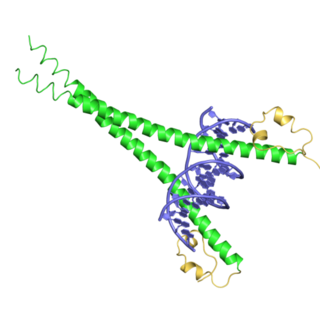Fos-related antigen 1 (FRA1) is a protein that in humans is encoded by the FOSL1 gene. [5] [6]
Fos-related antigen 1 (FRA1) is a protein that in humans is encoded by the FOSL1 gene. [5] [6]
The Fos gene family consists of 4 members: c-Fos, FOSB, FOSL1, and FOSL2. These genes encode leucine zipper proteins that can dimerize with proteins of the JUN family, thereby forming the transcription factor complex AP-1. As such, the FOS proteins have been implicated as regulators of cell proliferation, differentiation, and transformation. [6]
FOSL1 has been shown to interact with USF1 (human gene) [7] and C-jun. [7]

Protein c-Fos is a proto-oncogene that is the human homolog of the retroviral oncogene v-fos. It is encoded in humans by the FOS gene. It was first discovered in rat fibroblasts as the transforming gene of the FBJ MSV. It is a part of a bigger Fos family of transcription factors which includes c-Fos, FosB, Fra-1 and Fra-2. It has been mapped to chromosome region 14q21→q31. c-Fos encodes a 62 kDa protein, which forms heterodimer with c-jun, resulting in the formation of AP-1 complex which binds DNA at AP-1 specific sites at the promoter and enhancer regions of target genes and converts extracellular signals into changes of gene expression. It plays an important role in many cellular functions and has been found to be overexpressed in a variety of cancers.

Transcription factor Jun is a protein that in humans is encoded by the JUN gene. c-Jun, in combination with protein c-Fos, forms the AP-1 early response transcription factor. It was first identified as the Fos-binding protein p39 and only later rediscovered as the product of the JUN gene. c-jun was the first oncogenic transcription factor discovered. The proto-oncogene c-Jun is the cellular homolog of the viral oncoprotein v-jun. The viral homolog v-jun was discovered in avian sarcoma virus 17 and was named for ju-nana, the Japanese word for 17. The human JUN encodes a protein that is highly similar to the viral protein, which interacts directly with specific target DNA sequences to regulate gene expression. This gene is intronless and is mapped to 1p32-p31, a chromosomal region involved in both translocations and deletions in human malignancies.

Activator protein 1 (AP-1) is a transcription factor that regulates gene expression in response to a variety of stimuli, including cytokines, growth factors, stress, and bacterial and viral infections. AP-1 controls a number of cellular processes including differentiation, proliferation, and apoptosis. The structure of AP-1 is a heterodimer composed of proteins belonging to the c-Fos, c-Jun, ATF and JDP families.

Jun dimerization protein 2 (JUNDM2) is a protein that in humans is encoded by the JDP2 gene. The Jun dimerization protein is a member of the AP-1 family of transcription factors.

MYC proto-oncogene, bHLH transcription factor is a protein that in humans is encoded by the MYC gene which is a member of the myc family of transcription factors. The protein contains basic helix-loop-helix (bHLH) structural motif.

Transcription factor JunD is a protein that in humans is encoded by the JUND gene.

Myb-related protein B is a protein that in humans is encoded by the MYBL2 gene.

Transcription factor jun-B is a protein that in humans is encoded by the JUNB gene. Transcription factor jun-B is a transcription factor involved in regulating gene activity following the primary growth factor response. It binds to the DNA sequence 5'-TGA[CG]TCA-3'.

Cyclic AMP-dependent transcription factor ATF-3 is a protein that, in humans, is encoded by the ATF3 gene.

Protein C-ETS2 is a protein that in humans is encoded by the ETS2 gene. The protein encoded by this gene belongs to the ETS family of transcription factors.

Transcription factor PU.1 is a protein that in humans is encoded by the SPI1 gene.

Upstream stimulatory factor 1 is a protein that in humans is encoded by the USF1 gene.

ERG is an oncogene. ERG is a member of the ETS family of transcription factors. The ERG gene encodes for a protein, also called ERG, that functions as a transcriptional regulator. Genes in the ETS family regulate embryonic development, cell proliferation, differentiation, angiogenesis, inflammation, and apoptosis.

Transcription factor Maf also known as proto-oncogene c-Maf or V-maf musculoaponeurotic fibrosarcoma oncogene homolog is a transcription factor that in humans is encoded by the MAF gene.

Transcription factor MafG is a bZip Maf transcription factor protein that in humans is encoded by the MAFG gene.

ETS domain-containing protein Elk-4 is a protein that in humans is encoded by the ELK4 gene.

Fos-related antigen 2 (FRA2) is a protein that in humans is encoded by the FOSL2 gene.

AT-rich interactive domain-containing protein 3A is a protein that in humans is encoded by the ARID3A gene.

Basic leucine zipper transcription factor, ATF-like, also known as BATF, is a protein which in humans is encoded by the BATF gene.

MNT is a Max-binding protein that is encoded by the MNT gene
This article incorporates text from the United States National Library of Medicine, which is in the public domain.